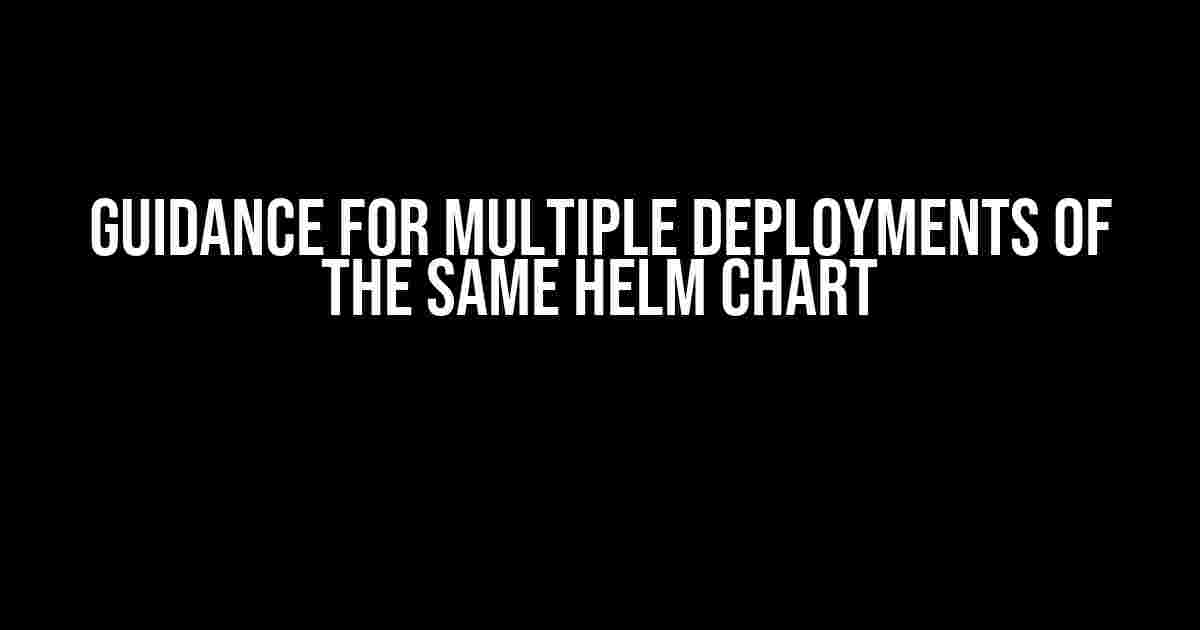When working with Helm charts, a common use case is to deploy the same chart multiple times within a Kubernetes cluster or across different clusters. This can be useful for creating multiple environments, such as dev, staging, and prod, or for deploying multiple instances of the same application. In this article, we’ll provide guidance on how to achieve multiple deployments of the same Helm chart.
Using Unique Release Names
One way to deploy the same Helm chart multiple times is to use unique release names. By default, Helm uses the chart name as the release name. To deploy the same chart multiple times, you can specify a unique release name using the `–set` flag.
For example, to deploy the `mychart` chart with a release name of `dev`, you can run the following command:
helm install --set release.name=dev mychartThis will create a new release named `dev` with the `mychart` chart. You can then repeat this process with different release names to create multiple deployments of the same chart.
Using Template Values
Another approach is to use template values to customize the chart for each deployment. Template values are placeholders in the chart’s templates that can be replaced with custom values during installation.
For example, you can create a `values.yaml` file with the following content:
env: dev
image:
tag: latestThen, you can install the chart with the following command:
helm install --values values.yaml mychartThis will deploy the chart with the `env` value set to `dev` and the `image.tag` value set to `latest`. You can create multiple `values.yaml` files with different values to customize each deployment.
Using Environment-Specific Values
A more advanced approach is to use environment-specific values for each deployment. This can be achieved by creating separate values files for each environment, such as `dev-values.yaml`, `stg-values.yaml`, and `prod-values.yaml`.
Each values file can contain environment-specific settings, such as database connections or API keys. You can then install the chart with the corresponding values file for each environment.
helm install --values dev-values.yaml mychart
helm install --values stg-values.yaml mychart
helm install --values prod-values.yaml mychartConclusion
In this article, we’ve provided guidance on how to achieve multiple deployments of the same Helm chart. By using unique release names, template values, and environment-specific values, you can customize each deployment to meet your specific needs.
Remember to always follow best practices for Helm chart development and deployment, including using version control and testing your charts thoroughly before deployment.
Frequently Asked Questions
Get the inside scoop on multiple deployments of the same Helm chart – we’ve got the answers to your burning questions!
What is the purpose of having multiple deployments of the same Helm chart?
Having multiple deployments of the same Helm chart is useful when you need to manage different environments, such as dev, staging, and production, or when you want to roll out a new version of your application to a subset of users. It allows you to keep each deployment separate and independent, making it easier to manage and maintain.
How do I configure my Helm chart to support multiple deployments?
To configure your Helm chart for multiple deployments, you can use templates and values files to customize each deployment. You can also use environment variables, such as `env:` or `release:` variables, to differentiate between deployments. Additionally, you can create separate `values.yaml` files for each deployment, and use `helm install` with the `–set` flag to override default values.
Can I use the same Helm chart for multiple deployments with different configurations?
Yes, you can use the same Helm chart for multiple deployments with different configurations. You can override the default values in the `values.yaml` file using the `–set` flag or by creating separate `values.yaml` files for each deployment. You can also use environment variables or annotations to customize each deployment.
How do I manage deployments with different Helm chart versions?
You can manage deployments with different Helm chart versions by using versioned releases. Each release can have its own version of the Helm chart, and you can use the `helm history` command to track changes and roll back to previous versions if needed. You can also use `helm upgrade` with the `–set` flag to upgrade to a new version of the Helm chart.
What are some best practices for managing multiple deployments of the same Helm chart?
Some best practices for managing multiple deployments of the same Helm chart include using consistent naming conventions, keeping track of deployment history, using version control for your Helm chart and values files, and testing each deployment thoroughly before promoting it to production.
